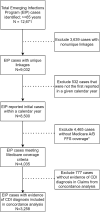Comparison of Medicare claims-based Clostridioides difficile infection epidemiologic case classification algorithms to medical record review by the Emerging Infections Program using a linked cohort, 2016-2021
- PMID: 40134335
- PMCID: PMC12034446
- DOI: 10.1017/ice.2024.204
Comparison of Medicare claims-based Clostridioides difficile infection epidemiologic case classification algorithms to medical record review by the Emerging Infections Program using a linked cohort, 2016-2021
Abstract
Background: Medicare claims are frequently used to study Clostridioides difficile infection (CDI) epidemiology. However, they lack specimen collection and diagnosis dates to assign location of onset. Algorithms to classify CDI onset location using claims data have been published, but the degree of misclassification is unknown.
Methods: We linked patients with laboratory-confirmed CDI reported to four Emerging Infections Program (EIP) sites from 2016-2021 to Medicare beneficiaries with fee-for-service Part A/B coverage. We calculated sensitivity of ICD-10-CM codes in claims within ±28 days of EIP specimen collection. CDI was categorized as hospital, long-term care facility, or community-onset using three different Medicare claims-based algorithms based on claim type, ICD-10-CM code position, duration of hospitalization, and ICD-10-CM diagnosis code presence-on-admission indicators. We assessed concordance of EIP case classifications, based on chart review and specimen collection date, with claims case classifications using Cohen's kappa statistic.
Results: Of 12,671 CDI cases eligible for linkage, 9,032 (71%) were linked to a single, unique Medicare beneficiary. Compared to EIP, sensitivity of CDI ICD-10-CM codes was 81%; codes were more likely to be present for hospitalized patients (93.0%) than those who were not (56.2%). Concordance between EIP and Medicare claims algorithms ranged from 68% to 75%, depending on the algorithm used (κ = 0.56-0.66).
Conclusion: ICD-10-CM codes in Medicare claims data had high sensitivity compared to laboratory-confirmed CDI reported to EIP. Claims-based epidemiologic classification algorithms had moderate concordance with EIP classification of onset location. Misclassification of CDI onset location using Medicare algorithms may bias findings of claims-based CDI studies.
Conflict of interest statement
No authors report a conflict of interest.
Figures



References
-
- Reveles KR, Pugh MJV, Lawson KA, et al. Shift to community-onset Clostridium difficile infection in the national veterans health administration, 2003–2014. Am J Infect Control 2018;46:431–435. - PubMed
LinkOut - more resources
Full Text Sources

